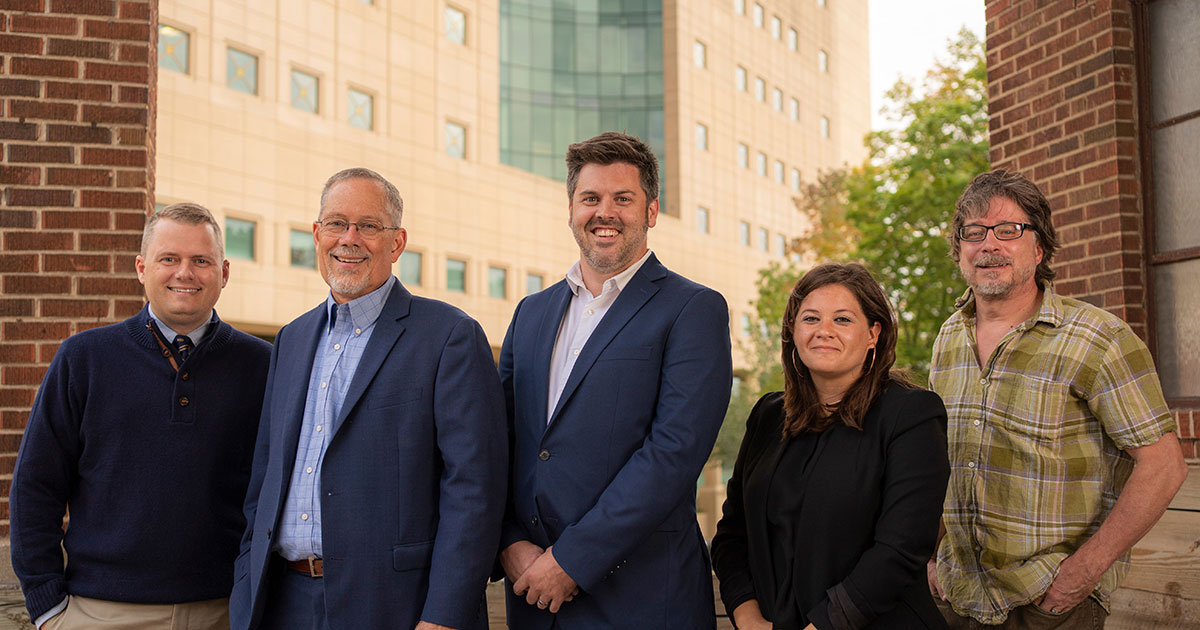
Wisconsin Legal Innovators (from left): Peter Tempelis, Waukesha County District Attorney’s Office; Lifetime Legal Innovator Keith Findley, U.W. Law School; Joe Keuler, State Public Defenders Office; Meghan Elledge, Wisconsin Department of Health Services; and Chris Lang, State Public Defenders Office. Photos: Andy Mannis
As the COVID-19 pandemic ebbed and flowed, courts began returning to in-person hearings, and law firms and other legal offices followed suit to some degree. In 2021, legal innovators in Wisconsin attempted to move the law and the profession forward on a wide variety of fronts. A majority of those chosen for the
Wisconsin Lawyer Legal Innovators award for 2021 work in the criminal law area.
The State Bar of Wisconsin has invited the legal community to help tell the story of legal innovation through the
That’s a Fine Idea: Legal Innovation Wisconsin initiative.
The goal of this program, now in its eighth year, is to showcase the people behind the best examples of legal innovation to help lawyers thrive in an ever-changing and highly competitive legal marketplace.
The State Bar began the legal innovators project in 2014 to tell the stories of those making imaginative and positive changes, hopefully inspiring others to do the same, says Tom Watson of the State Bar of Wisconsin
Communications Committee’s Legal Innovation Subcommittee. “This year, we had no shortage of nominees who went beyond the norms of how they serve their clients and developed new ways to fill needs that they saw,” he says.
Attorneys in Wisconsin and elsewhere face challenges such as increasingly sophisticated clients who expect better service, information, and accessibility, requiring lawyers to use technology to its fullest, and developing new systems and procedures to better serve clients, Watson says. “Without innovation and adaptation, clients will look elsewhere for help in resolving their legal matters, or be left without any help whatsoever,” he says.
Lifetime Legal Innovator Keith Findley, a professor at the University of Wisconsin Law School, co-founded the
Wisconsin Innocence Project in 1998 and has been involved in combating wrongful convictions and promoting forensic sciences ever since. He was chosen due to his influence on the legal profession and the many lives he’s changed over the past 30 years, Watson says, noting that Findley also served as president of the worldwide Innocence Network. “His impact on our legal system during the past three decades cannot be understated,” he says.
Watson gives a quick rundown of the other legal innovators. “We are recognizing a lawyer who has made a huge difference in tearing down the barriers to inclusion and equity for people of all races, nationalities, and genders when it comes to employment and healthcare opportunities,” he says. Two honorees from the
State Public Defenders Office have improved the services that office provides, Watson adds, “one through a large-scale technology upgrade during the pandemic, which, among other things, responded to the mass migration to Zoom-based court hearings; and the other by developing videos to help better tell the stories of defendants and the circumstances that led them to the legal system.”
Another honoree developed the free, web-based app
Legal Tune Up, which “helps Wisconsin residents access publicly available records on eviction notices and old criminal records,” Watson says. “This helps them determine if any of these records are eligible for removal. Many individuals, with the help of this app, have the chance to access better jobs, housing, and education. Finally, another lawyer we feel is deserving of recognition has worked to improve the system when dealing with domestic violence cases, juvenile offenders and others, in ways that no one else had considered.”
Lifetime Innovator Keith Findley: Improving Forensic Science in Courtrooms
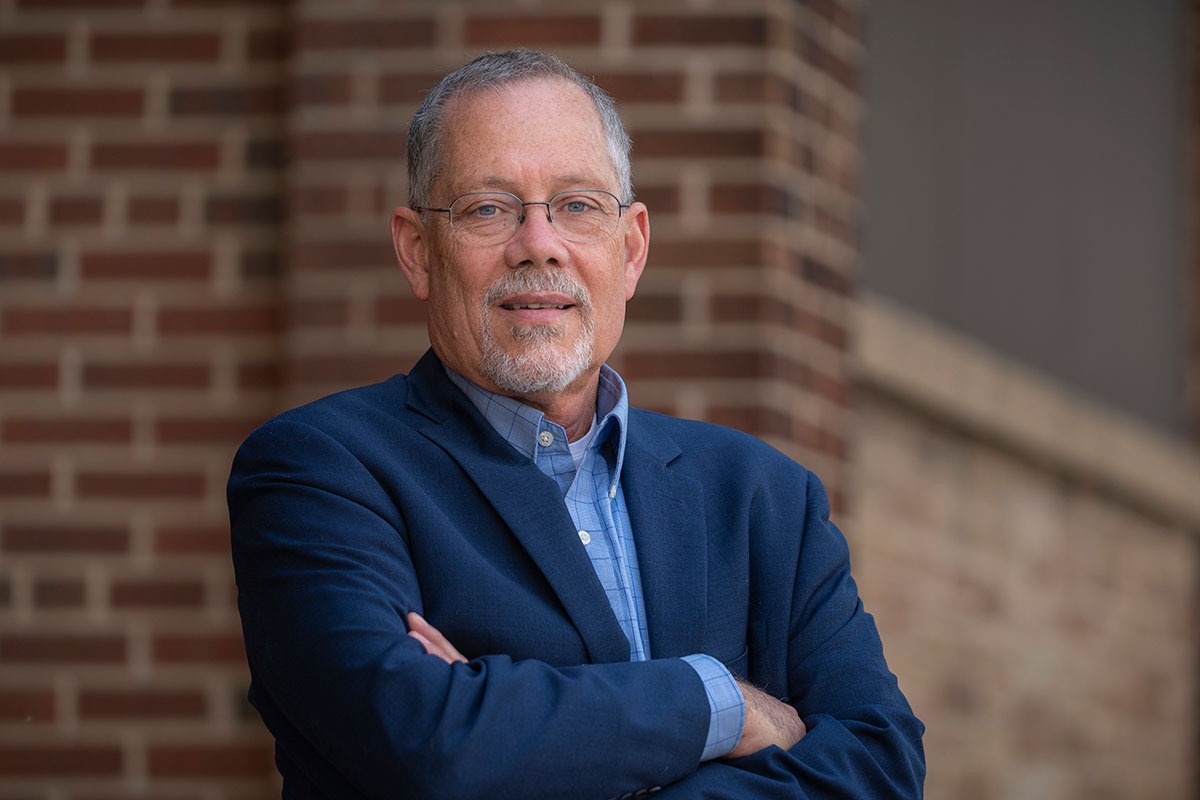
Keith Findley, this year’s Lifetime Legal Innovator, has a career-long passion to combat wrongful convictions and promote forensic sciences. He co-founded the
Wisconsin Innocence Project in 1998, serving as co-director until 2017; he has been a senior advisor since then. The Wisconsin Innocence Project is a training ground for criminal-defense lawyers and seeks to exonerate individuals who were wrongly convicted based on faulty forensic science. He also served five years as president of the worldwide Innocence Network. He was chosen due to his impact on the legal profession and the many lives he’s changed over the past 30 years.
Findley, who teaches courses on evidence, wrongful convictions, criminal procedure, and law and forensic science at the University of Wisconsin, has taught for most of his career. He also spent six years as an assistant state public defender in both the trial and appellate divisions, litigating hundreds of postconviction and appellate cases.
Findley co-founded the Wisconsin Innocence Project with Professor John Pray in 1998 and served as co-director until 2017; he has been a senior advisor since then. The Wisconsin Innocence Project is a training ground for criminal-defense lawyers and seeks to exonerate individuals who were wrongly convicted based on faulty forensic science.
He served for five years as president of the Innocence Network, comprised of almost 70 innocence organizations around the globe, and in 2018 he co-founded the nonprofit
Center for Integrity in Forensic Sciences, which works to make criminal prosecutions safer and more reliable.
Know a Legal Innovator?
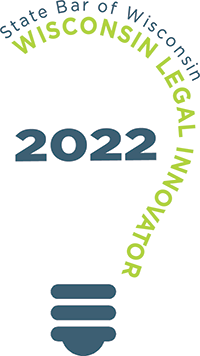
Are you one? Nominations open March 1 and close on June 30. To learn more, visit
ThatsaFineIdea.com.
“I went to law school because I was going to save the world and strike blows for justice,” Findley says. In law school, he became involved in a clinical program representing prison inmates; he reflects that “it’s hard to find a segment of our population that is more disadvantaged and in more need of legal assistance.” Findley’s interest in this area made him a natural fit to join the U.W. faculty and its prison-based clinic.
Findley left to spend time as a public defender to get more intensive training as a litigator. “Through that work, I learned a lot about the system and the ways that the system disadvantages the accused,” he says. By the time he returned to the law school, DNA profiling had been brought forward as a forensic tool, shattering the accepted wisdom that “occurrences of wrongful conviction had to be freakishly rare,” he says. DNA evidence “showed that on a rather regular basis, we convict innocent people.”
When Findley and Pray launched the Wisconsin Innocence Project – the third of its kind in the country – they hoped to find a pool of cases in which DNA evidence would show the system had gotten it wrong. But they weren’t sure they would find any. “That turned out not to be a serious concern,” he says. “Pretty soon, we had more cases than we could possibly handle.”
The larger innocence movement has changed conventional wisdom about criminal justice and opened people’s eyes to the systematic nature of error, Findley believes. During his five years as president of the national and global Innocence Network, the organization “grew up and became professionalized,” he says, with a regular budget, a full-time staff, and resulting greater capacity to support exonerees and member chapters. “The network has been a really important entity for providing support, connection, communication, and learning, for not just the innocence organizations and the advocates, but also for the exonerees,” he says.
The concept of the Center for Forensic Integrity arose from the fact that forensic science flaws are second on the list of reasons that wrongful convictions happen, behind eyewitness misidentifications, Findley says. Little had been done to rectify this situation, he says.
Findley worked with Jerry Buting and Dean Strang – who gained nationwide recognition as Steven Avery’s attorneys in the Netflix series
Making a Murderer – to launch the center. They work to educate judges, attorneys, and law students; influence and participate in litigation from filing amicus briefs to taking on direct representation; and lobby for policymaking.
Findley became involved in local police reform in 2015 when Madison Mayor Paul Soglin appointed him to an ad-hoc committee that released a 177-recommendation report in October 2019, the “capstone” of which was to create more robust civilian oversight mechanisms for police officers. This has ensured that the police were living up to the other expectations and helped to build a bridge between the police and communities, Findley says.
Findley says he finds innovative ideas for reform through proximity to those affected, for example “by going into the prisons on a regular basis, meeting with imprisoned people, and finding out how the system treats them,” he says. “That sparks ideas about how to work to improve the way our society and our community responds to the problems we see.”
Overall, Findley says the nature of the legal process can stand in the way of innovation, given deference to authority and to precedent. “Precedent has an important place,” he says. “But that, combined with respect for authority, and the hierarchical nature of the courts, creates a built-in inertia that makes it hard for lawyers to think outside the box.”
Peter Tempelis: Creating a Raft of Prosecutorial Reforms
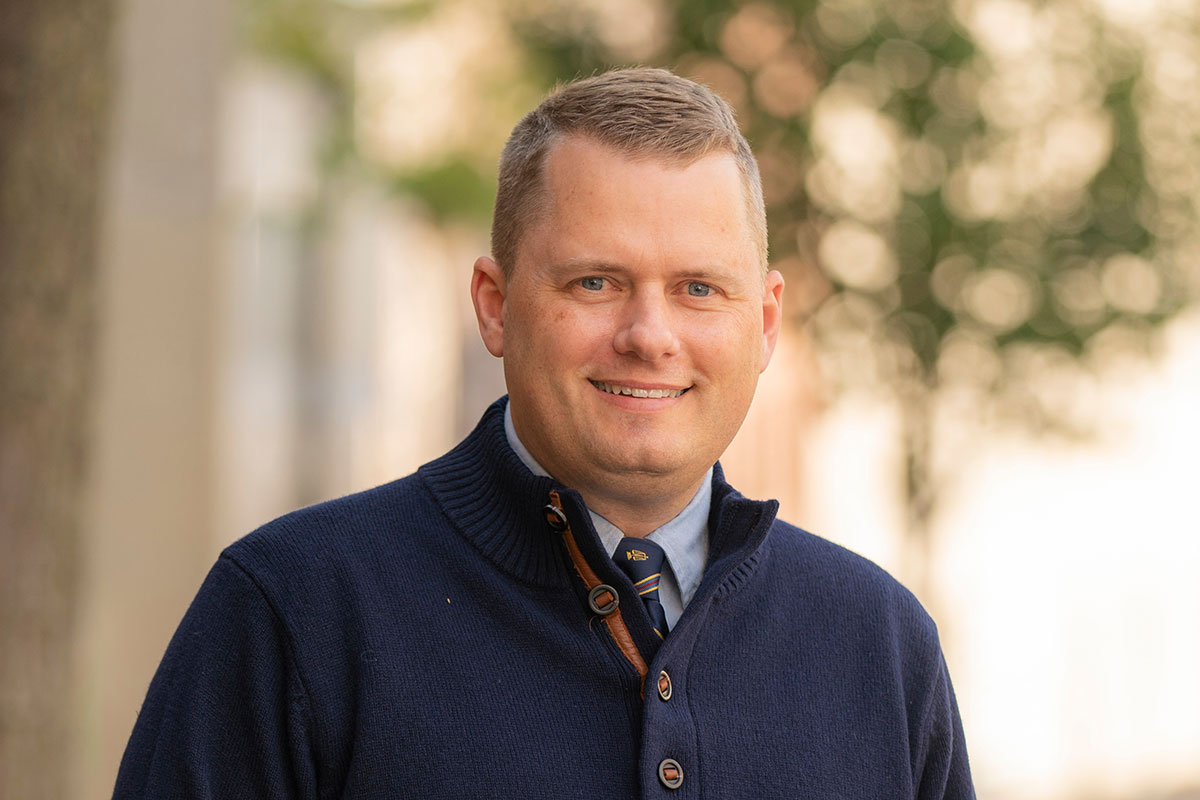
Waukesha County assistant district attorney
Peter Tempelis and his colleagues have implemented initiatives aimed at issues such as the opioid epidemic, by creating a drug treatment court program; domestic violence, by addressing underlying power and control issues and related challenges to prevent homicides; healthcare and elder fraud, by increasing enforcement capacity and expertise; and retaining talented prosecutors, by promoting a statewide pay progression plan aimed at closing the salary gap.
Waukesha County assistant district attorney Peter Tempelis and his colleagues have implemented a smorgasbord of initiatives aimed at issues such as the opioid epidemic, domestic violence, healthcare and elder fraud, and retention of talented prosecutors.
To combat opioid abuse, Tempelis drew from his experiences in the Jefferson County District Attorney’s Office. Social workers approached him about wanting to create a drug treatment court program. Tempelis wrote up the policies and procedures, and the court system approved the concept. “The goal of it was to try to attack the second phase of the opioid epidemic, to try to address [people’s] treatment needs,” he says.
Tempelis has participated in several initiatives related to domestic violence, challenging limits to the admissibility of out-of-court statements, tackling chronic and high-risk recidivism, undertaking the largest multijurisdictional lethality assessment program in the country, increasing domestic violence enforcement in Milwaukee County, and co-locating Milwaukee County’s domestic violence unit at a shelter called Sojourner Family Peace Center.
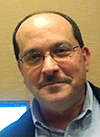 Ed Finkel is an Evanston-based freelance writer.
Ed Finkel is an Evanston-based freelance writer.
“The big key with all of those is, it’s basically homicide prevention,” Tempelis says. “It’s trying to identify relationships where there’s a high risk of lethality. It’s to try to find ways to work with victims and find out what their needs are; and the same for suspects, if there’s a way to reduce their risk of violence, that’s what we want to do.”
The initiatives attempt to address underlying power and control issues as well as related challenges like alcohol or drug abuse and then to provide witness protection and investigate witness tampering, Tempelis says. “We try to be a clearinghouse in the DA’s office for those assessments,” he says. “As a consequence, we have better outcomes overall, including with homicides.” Among the successes, domestic violence felony cases doubled and felony jury trials tripled between 2012 and 2016, he added.
The efforts to combat healthcare and elder fraud aimed to increase enforcement capacity and expertise; they have resulted in a tripling of Medicaid fraud prosecutions between 2016 and 2019. “It’s aimed to try to identify the needs of law enforcement to enhance investigations, and in turn to prosecute those kinds of offenses,” Tempelis says. “You’ll see a healthcare provider providing a service, but they’re just doing it to make money; they’re neglecting the patient. We’re trying to use some of the same strategies we’ve had to use with child abuse and domestic abuse in the context of elder abuse.”
To ensure that talented attorneys stay in public sector units such as district attorney, public defender, and the attorney general’s offices, Tempelis worked to promote a statewide pay progression plan aimed at closing the salary gap vis-à-vis what attorneys could make by leaving for the private sector. “When you lose somebody, you’ve got to start over,” he says. “It’s a brain drain, knowledge drain, skill drain. And you lose money.” Resulting changes in state law and policy led to a 17-step salary schedule culminating in a $126,000 annual salary, well above what prosecutors had earned previously. “It doesn’t get rid of the problem, but it helps,” he says.
Legal innovations stem from watching one’s own system to see what works and what doesn’t as well as looking at what other jurisdictions have tried, Tempelis says. Attorneys need to be open to talking outside the box, with prosecutors and defense attorneys, for example, exchanging ideas and finding ways for the system to work better, he says.
The drug treatment court, for example, has proved to be a “less adversarial, more collective partnership, across the aisle, to try to work together,” Tempelis says. “If you’re not addressing the underlying problem, the person is just going to come back into the system. You need to think strategically and tactically to say, ‘Isn’t there a better way to do this?’” Sometimes there isn’t under current law, in which case attorneys need to approach the legislature and attempt to change the underlying public policy, he adds.
Joe Keuler: Bolstering Efficiency, Effectiveness of Public Defense
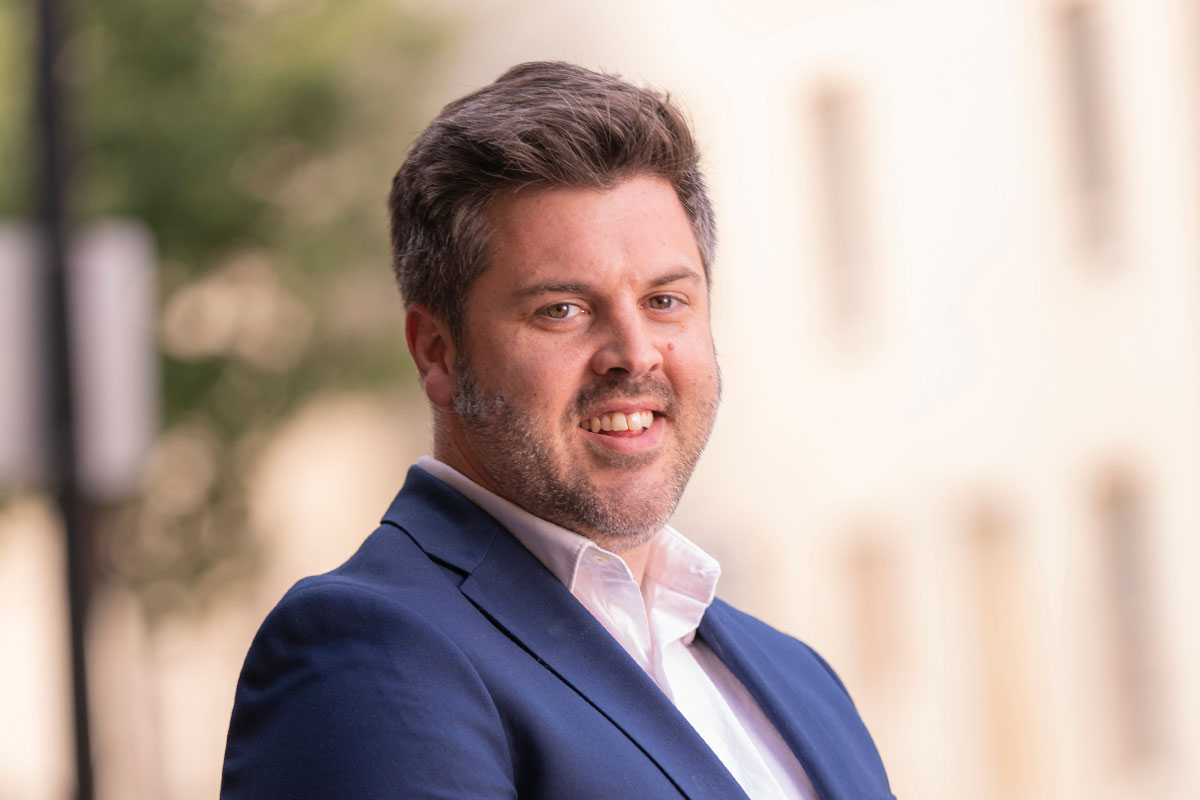
Joe Keuler, information technology director in the
State Public Defenders Office, led a large-scale technology and services upgrade that has included pilot projects for automatic calendar syncing as well as providing storage and access for criminal e-discovery. The automatic syncing tool assists staff attorneys who face a high volume of hearings and challenges organizing and reconciling their calendars. His team also spearheaded a seamless process for downloading and accessing large amounts of criminal e-discovery data.
In the State Public Defenders Office, one of two legal innovators is Joe Keuler, information technology director, who led a large-scale technology and services upgrade that has included pilot projects for automatic calendar syncing as well as providing storage and access for criminal e-discovery.
Keuler’s work aims to assist staff attorneys who face a high volume of hearings, as well as challenges organizing and reconciling their calendars. The team Keuler led has developed an automatic syncing tool that provides a single, reliable source for court hearings, while also spearheading a seamless process for downloading and accessing large amounts of criminal e-discovery data.
“It’s about moving the data and information closer to where our clients are, and meeting the attorneys’ schedules and what’s required with their jobs,” says Keuler, who leads a team of six IT specialists. “That means bringing them the data, whether it’s in jail or in court, or on the road – wherever they need it and at the time they need it.”
In addition to the Google calendar syncing functions, a new telephonic solution allows for texting with clients, wider provision of laptops for portability, and the effort to handle the volume of electronic discovery.
“With all the 4K bodycam footage, squad cams, cellphone dumps – that is changing the game and doing it fast,” Keuler says. “We’ve been making a lot of moves in that area to organize that data and to help save time. We are in the process of building an application that automatically downloads the discovery. We’re preparing for digitizing a huge portion of how we do business and manage files. We’re on the precipice of that.”
Overall, Keuler believes his office is working to keep up with changes in the world, ranging from greater use of texting to electronic data, to keep staff working as efficiently and effectively as possible. His most innovative ideas come from the people doing the work. “The organization has provided a lot of great ideas,” he says. “It’s a whole team effort. … Part of that is just being open and available to accept feedback so they feel comfortable asking for things.”
Attorneys tend to be creative people, Keuler has found. “I didn’t make up these ideas; I put the solutions together,” he says. “These are their innovations. I’m just making it happen with my team. Public defenders have incredible caseloads. They all have innovative processes or unique ways of doing things. They come up with ideas on how to be efficient.”
Nicholas Smith, assistant state public defender in the Merrill office, one of the pilot sites, says he nominated Keuler due to the positive impacts these technology initiatives have had on the five-person office that covers five counties north of Wausau. “When you’re a public defender, a high-volume practitioner, having a computer script to audit your calendar and make sure you’re not missing court is huge,” he says.
The ability to more efficiently handle e-discovery has also been a boon, Smith says. “The large volumes of it were unprecedented. The public defender’s office is the largest law firm in the state,” he says. “It was above and beyond that Keuler was able to do it. His staff are always up here, and I make sure to take them out for a drink when they are.”
Chris Lang: Client Advocacy and the Power of Video
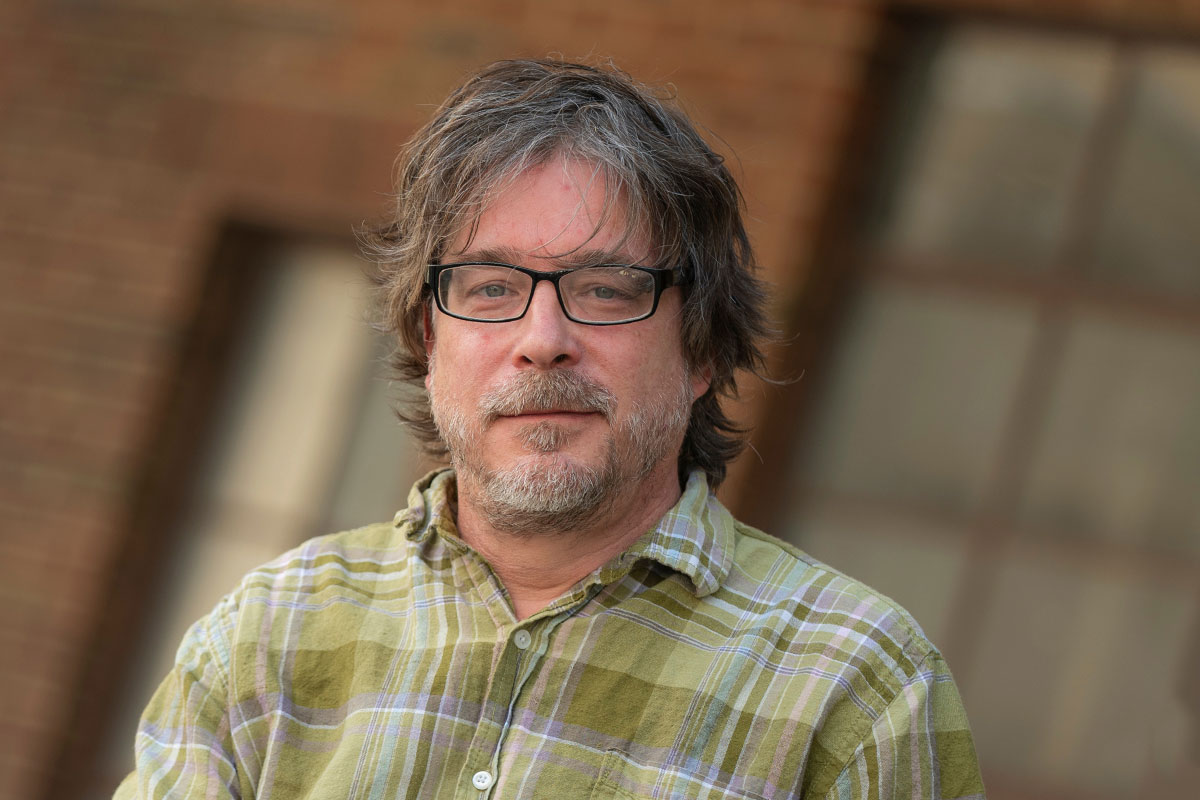
Chris Lang, a video mitigation specialist with the
State Public Defenders Office, films defendants and people close to them, talking about their back stories, with the goal of humanizing them in the eyes of judges and jurors. The videos he puts together add a new dimension to the SPD’s effectiveness, underscoring the fact that defendants are people too, with a past that might at least help to explain the crimes they have been convicted of committing. Judges have noted that the videos help them understand clients better, and assisted the negotiating process with prosecutors. More important, clients feel heard.
The other SPD innovator is Chris Lang, a video mitigation specialist who films defendants and people close to them, talking about their back stories, the goal of which is to humanize defendants in the eyes of judges and jurors.
The videos that Lang puts together add a new dimension, underscoring the fact that defendants are people too, with a past that might at least help to explain the crimes for which they have been convicted.
“It wasn’t really in my job description,” Lang says. But when a now-retired staff attorney suggested the concept, “I did it, and it was trial by fire. I jumped right into a double homicide.” The concept spread slowly through the state public defender’s office at first, by word-of-mouth, and people came to him when they thought they had a sympathetic client.
At this point, he’s done probably 70 of them. “I get to interact with these clients directly,” Lang says. “Even if it doesn’t have an overt outcome on the case, they feel represented. We took the time to sit down with them and their family members and just listen.”
Those in the system also appreciate it. “Judges like the fact that I’m filtering it down to a 10-minute piece,” he says. “The judges appreciate hearing about the client, outside of the criminal complaint and what the police had. We do video because we want them to see the faces of the people and feel the emotions.”
Attorneys were on hand when Lang first produced the videos, but now he usually meets with them ahead of time to ask what mitigating circumstances they hope the video will bring to light. Lang believes he has more success getting defendants to open up without an attorney present. “I look like a hippie; I have long hair, and I’m not a formal dresser,” he says. “They appreciate someone without a suit coming in.”
Lang adds that he also reassures defendants that he’s held to the same rules of confidentiality as lawyers. “And I’m curious,” he says. “I say, ‘Think of me as some normal person in society, somebody who might be on the jury, who has certain biases.’ … Once they warm up, they express themselves and talk about the traumatic events in their lives.”
The innovation comes in working with the attorneys and clients to figure out who can speak to their story, such as family members, employers, landlords, or people in the community with whom they might have served as volunteers, Lang says. Some public defenders have been “repeat customers” more than others, he says. “The lawyers that I’ve been working with consistently, they do think outside the box about it.”
Beth Stockbridge, an assistant public defender in Shawano County who nominated Lang, does hundreds of sentencing arguments every year and says Lang’s videos tell her clients’ stories very well. “A big part of being a public defender is having the privilege of telling our clients’ stories,” she says. “Many of our clients have made bad decisions. Many of them have also gone through a great deal of trauma.”
People in the criminal justice system – judges, prosecutors and defense attorneys alike – watch people’s lives float by them, often without connecting as much as they should, Stockbridge believes.
Stockbridge says judges have noted the videos have helped them understand clients better, and she thinks they’ve helped at times in negotiating with district attorneys’ offices. More important, clients feel heard. “Often times, when people go through the criminal justice system, they feel like cogs in the machine,” she says. “They don’t feel like they’ve been heard or that anyone understands how they got to that point in their lives.” Most ask for a copy of the video, which she finds counterintuitive given that the video is about “one of the worst times in their lives,” she adds. “It’s because they feel heard and understood.”
Lift Wisconsin: Legal Tune Up and Clearing Records to Move Forward
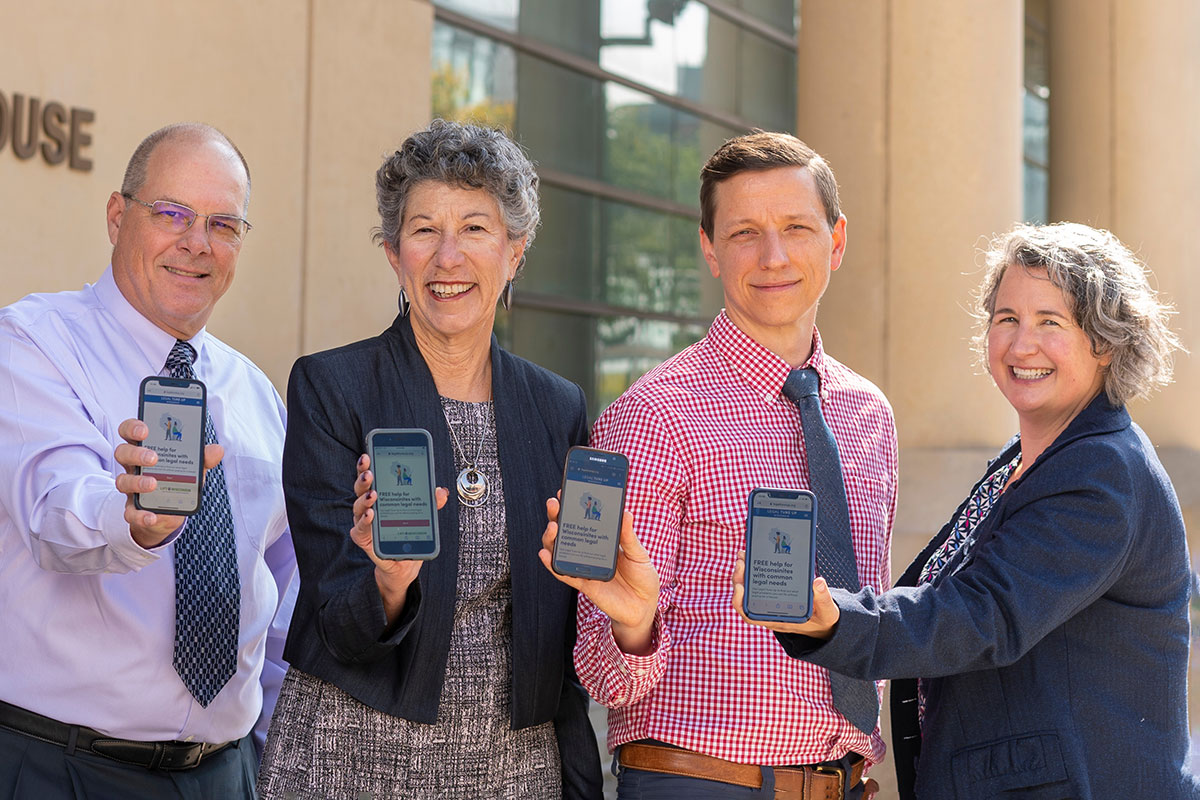
Legal Tune Up, an app created by social justice initiative
LIFT Wisconsin – a collaborative effort led by director Marsha Mansfield (second from left) – was developed on behalf of Wisconsin residents who have criminal or eviction records that prevent them from accessing employment or housing opportunities. The app gives residents a chance to clear their records and move forward with their lives by enabling them to find publicly available – but tricky to access and make sense of – data in state or county databases. The app then allows them to create and file the needed paperwork. Members of the LIFT Wisconsin team (from left):
Jon Danforth,
Marsha Mansfield,
Mitch, and
Sarah Davis.
Another legal innovator award recognized an app developed on behalf of the thousands of Wisconsin residents who have criminal or eviction records that prevent them from accessing employment or housing opportunities.
Legal Tune Up, the app created by social justice initiative
LIFT Wisconsin, provides residents a chance to clear their records and move forward with their lives by enabling them to find publicly available – but tricky to access and make sense of – data in state or county databases. The app then allows them to create and file the needed paperwork.
LIFT Wisconsin stemmed from a common realization of the catch-22 faced by people with certain types of records and no resources to access legal assistance. The immediate impetus was a challenge competition initiated by Schmidt Futures, a nonprofit founded by Google CEO Eric Schmidt and his wife, Wendy, for public universities to create technology solutions to increase their community’s prosperity.
“Our proposal embodied a very technology-based solution,” says Marsha Mansfield, director of LIFT Wisconsin, a collaboration among civil legal clinics at the University of Wisconsin Law School, the Economic Justice Institute, the Center for Patient Partnerships, Legal Action of Wisconsin, and the Employment and Training Association of Dane County. “What if we could make it easy for people to use a computer or a phone to access the same public data that employers and landlords and others are accessing?” she says.
The project has faced challenges in working with governmental agencies to make the data usable and understandable to laypeople, given that such agencies often have very old systems for maintaining data and are not accustomed to working with a nonprofit organization trying to help individuals, Mansfield says. “If you ever tried to look at your driver’s license record, depending on how many violations you have, it can be very long, complicated, and difficult to understand,” she says.
Sarah Davis, assistant director of LIFT Wisconsin, says the organization hopes the project will not only help those affected with specific data but also instill in them a sense that the law can be a solution to their problems. “We want people to have legal health – like having a dental appointment or getting their oil changed,” she says. “We’re also trying to change mindsets and behaviors within these public agencies.”
Landlords, employers, and universities that use such data to make housing, hiring, or admissions decisions are “repeat players” who have systems in place and people whose job it is to access such records, Davis notes. “As individuals, it’s not something we’re habitually doing,” she says. “These systems aren’t designed for it to be easy for a layperson to take care of these things.”
Mansfield believes that “many lawyers are absolutely wonderful innovators” who “think creatively and think outside the box” in solving problems. “What’s important to me is that we amplify this message and work collaboratively across disciplines,” she says. “That means the government as well as nonprofits as well as private attorneys. We’ve had some wonderful partnerships and support from the private bar in making this a reality.”
The Schmidt Futures challenge encourages LIFT Wisconsin to think more boldly and audaciously, Davis says. “It is really easy when you’re doing public interest law to be in a scarcity mindset – can we get enough money to hire a half-time person?” she says. “It’s better to try big and fail, because you will accomplish a lot in that process, than to not go for it.”
Meghan Elledge: Targeting Health Disparities through the Office of Health Equity
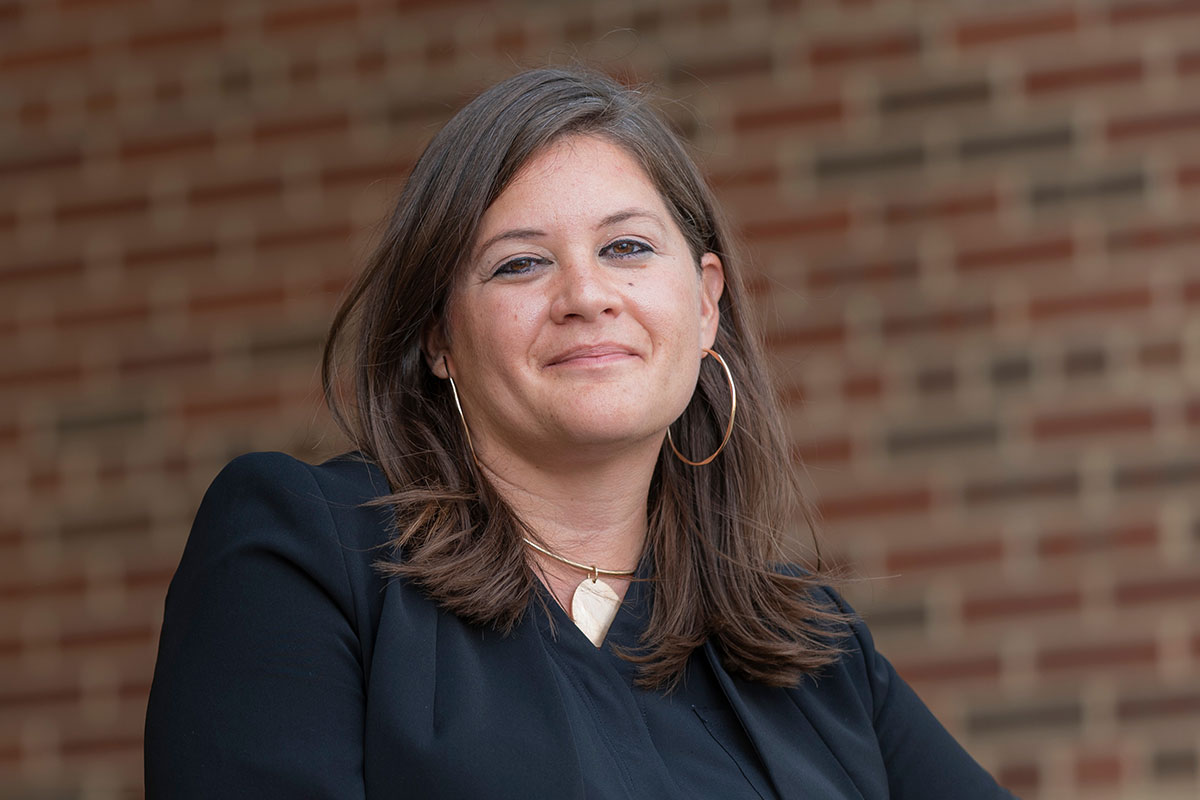
Meghan Elledge, then a staff attorney in the state Department of Health Services (DHS), led the creation of an
Office of Health Equity to raise awareness, build culture and infrastructure, provide leadership, ensure coordination, undertake data analysis, form partnerships and, ultimately, minimize disparities. The office includes several staff members focused on both internal and external policies, retention and recruitment, workplace culture, communications strategy, grantwriting, and office administration. A program focused on minority health was moved into the new office, and a pipeline for interns was put into place.
Barriers to equity and inclusion in healthcare disproportionately affect Black, Native American, and Latinx populations in Wisconsin and around the country. After the death of George Floyd in May 2020, Meghan Elledge, then a staff attorney in the Wisconsin Department of Health Services (DHS), was inspired to lead the creation of an
Office of Health Equity to raise awareness, build culture and infrastructure, provide leadership, ensure coordination, undertake data analysis, form partnerships and, ultimately, minimize disparities.
Elledge, who recently left the state to become senior health policy strategist for San Diego (Cal.) County supervisor Terra Lawson-Remer, undertook this effort on top of her job as a staff attorney advising the Medicaid Division along with other duties as assigned. She notes that many organizations were having similar conversations about the health equity issues underscored by the COVID-19 outbreak, but the solution was often simply to hire a diversity, equity, and inclusion director.
When that idea came up at the DHS, Elledge pushed back because such positions often “check the box” but don’t come with the authority or resources to make actual change. “To me, it was important to say, ‘Yes, bringing in a director should be part of this, but how do we create that fertile ground and create a support system that will support and let this director be successful,’” she says.
The resulting office includes several staff members focused on both internal and external policies, retention and recruitment, workplace culture, communications strategy, grant-writing, and office administration. A program focused on minority health was moved into the new office, and a pipeline for interns was put into place, Elledge says. Then-DHS Secretary Andrea Palm and current Secretary Karen Timberlake were very supportive, she says. Deputy secretary Julie Willems Van Dijk “was a champion and fierce leader,” chief legal counsel Sandra Rowe served as executive sponsor and mentor, and Tonya C. Evans co-led the workgroup.
“When you talk about DEI work, there’s a lot of folks that want to change hearts and minds, which is great,” Elledge says. But her group followed an action-first philosophy: “You don’t want to change Hearts and minds before you change policy structure. We want to create a sustainable, equitable structure. Hearts and minds will follow.”
As someone with a social justice background, Elledge says she looks at barriers as opportunities. As the daughter of a teenage mother and third-generation Mexican-American on her mother’s side – whose grandmother died of heart disease at age 60 and whose mother had a heart attack in her 50s – health disparities hit close to home. “Who are the individuals impacted by this?” she says. “I tried to elevate those stories and make the focus more about that, than government bureaucracy. That was what motivated me to do this work on top of my day job.”
Lawyers have often taken on the role of societal innovators and change agents, Elledge says, pointing to the late Thurgood Marshall and Ruth Bader Ginsburg and the work they did before becoming U.S. Supreme Court Justices as prime examples. “We challenge the status quo,” she says. “We’re fighting on behalf of people who have no voice.” But challenging the status quo does not always come easy within large systems, she adds. “We’ve inherited policies that have implicit biases and racism. It’s easy to make small changes. We wanted to dismantle that broken structure.”
The challenge in doing such work is to find the optimal pathway, Elledge says. “I’m pretty relentless,” she says. “Somebody will come to us and say, ‘This is what we want to do.’ We might have to say, ‘That pathway won’t work, but let me find another pathway that will support what you’re needing.” She adds that she couldn’t have imagined in the summer of 2020 that the Office of Health Equity would be already up and running. “Every time I heard a ‘no, we can’t do this,’ I tried to think of another pathway,” she says.
Anne Bensky, deputy chief legal counsel at the DHS, nominated Elledge because she was “blown away” by the concept and execution. “I’d never seen a young lawyer with the courage and the gumption, in an agency of 7,000 people, to create a new office directly connected to the secretary’s office in the middle of a pandemic, when this agency was already undertaking so many other things,” Bensky says. “The fact that she had the energy and tenacity to continue to push, and find solutions where there were a lot of roadblocks, I thought it was important to show other lawyers in Wisconsin that this could be done.”
Looking Forward
The 2021 Wisconsin Legal Innovators join a talented group of Wisconsin lawyers and legal professionals who are doing innovative things to keep the legal system moving in the right direction, while offering solutions for the people of the state.
“This year, we highlighted some outstanding things that are happening in the criminal law area, as well as health equity, which can often be related. Establishing healthy communities and offering support when needed helps individuals stay out of the criminal justice system,” said Watson.
Watson said there were numerous examples of innovation submitted this year, but the Communications Committee’s Legal Innovation Subcommittee could only select six.
“We are seeing so many great examples of innovation, and we will continue to highlight and recognize those innovations through the
That’s a Fine Idea: Legal Innovation Wisconsin initiative. If you are seeing legal innovation in your area, submit your nomination for 2022.”
Hey Innovator, What Do You Think?
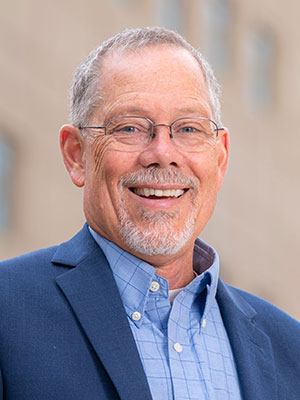 Keith Findley: What do you do to relax and recharge?
Keith Findley: What do you do to relax and recharge?
Years ago, I took a class in bowl turning – the art of turning a block of wood on a lathe to make a bowl. Now, when I need a break from the law, I get pleasure from finding a freshly cut or fallen tree, cutting it into chunks, and making it into a functional piece of art.
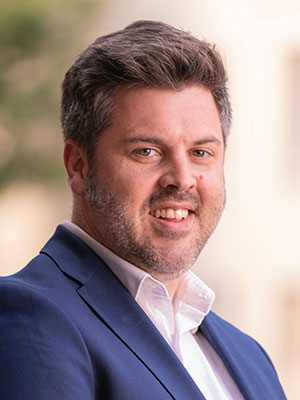 Joe Keuler: How do you spot opportunities to innovate?
Joe Keuler: How do you spot opportunities to innovate?
I spot opportunities to innovate by actively listening for high-impact ideas and learning how existing processes work. From there, it’s applying the right technology solutions to make it happen. Finding the right IT solution comes down to knowing the technological art of the possible.
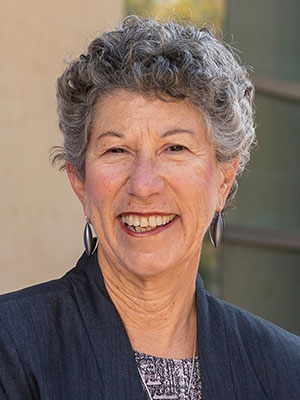
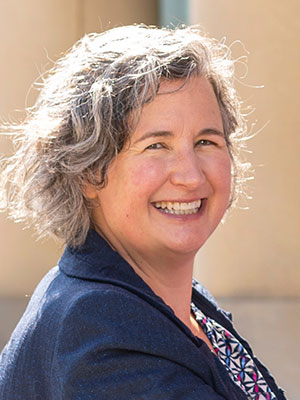 Marsha Mansfield and Sarah Davis, Lift Wisconsin: What gets in the way of lawyers innovating?
Marsha Mansfield and Sarah Davis, Lift Wisconsin: What gets in the way of lawyers innovating?
Daring to innovate requires a willingness to fail spectacularly. Innovating to solve intractable problems like access to justice means trying out-of-the-box ideas that can be risky, expensive, and time consuming. Among the biggest barriers are system barriers such as antiquated state database systems that stymie innovative efforts and the system’s fear of innovation.
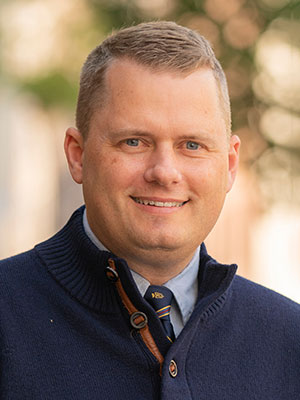 Peter Tempelis: How do you go from idea to action?
Peter Tempelis: How do you go from idea to action?
Ultimately, going from idea to action is about collaboration and engaging in diligent effort and perseverance. In the criminal justice system, a prosecutor’s goal is not the pursuit of conviction but rather justice. In our context, an innovative idea should provide an opportunity to obtain greater justice and public safety. That means we, as prosecutors, must reach out to justice partners, like law enforcement officers, the defense bar, or the courts, to ask questions and suggest, when appropriate, that perhaps we can do better.
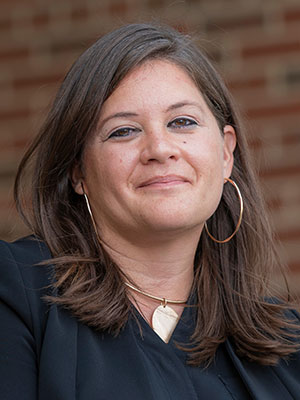 Meghan Elledge: How do you go from idea to action?
Meghan Elledge: How do you go from idea to action?
I get curious. I ask a lot of questions and really listen to other people’s expertise. Who will this action affect? What is the process? What are the barriers? I find allies who feel passionate about the idea. Has this idea worked or failed in another industry or region? I strategize and map out the steps needed to bring the idea into a reality. It becomes my roadmap.
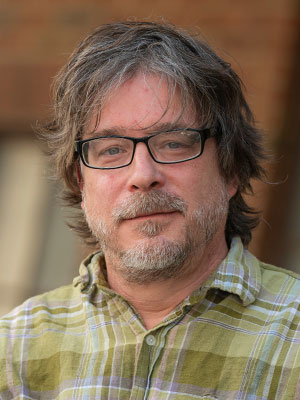 Chris Lang: How do you get your best ideas?
Chris Lang: How do you get your best ideas?
I have the privilege of working with a great team of attorneys, investigators, and client support specialists who view our cases from a variety of vantage points – both personally and professionally. We listen to the client’s story, talk with family members and other community advocates, learn about the priorities of the community, and come up with an effective way to tell the client’s story.
» Cite this article:
94 Wis. Law. 16-25 (November 2021).
